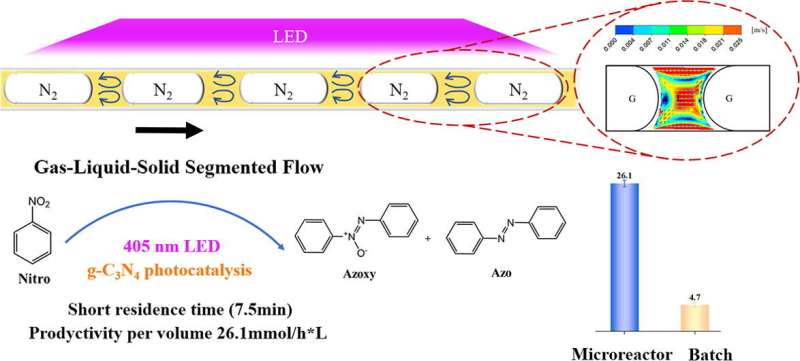Researchers propose novel approach to enhance heterogeneous photosynthesis of azo- compounds

Photocatalytic reactions, which unlock chemical transformations under mild conditions that are unavailable to conventional ground-state pathways, can save energy consumption and improve intrinsic safety of the processes. As a sustainable and low-carbon technology, it has high potential in the commitment to carbon peak and carbon neutrality.
Continuous flow chemistry can, to a large extent, migrate the "light limitation" problem in traditional batch protocols, and the use of heterogeneous photocatalysis can overcome the disadvantages of difficult catalyst recovery in homogeneous systems. However, effective handling of the solid photocatalysis in continuous flow still remains a challenge.
In a study published in the Chemical Engineering Journal, a team led by Prof. TANG Zhiyong and Assoc. Prof. ZHANG Jie at Shanghai Advanced Research Institute of the Chinese Academy of Sciences reported a novel approach to utilize the solid photocatalysis in continuous flow without clogging with the employment of gas–liquid-solid segmented flow. This approach, owning to the inner recirculation in liquid segments and the formed thin film, ensures the effective suspension of solid catalysts in flow, resulting in enhanced mass transfer and irradiation.
Azobenzene and azoxybenzene are important precursors in pigment industry, electronic industry and pharmaceutical industry. In this study, the selective synthesis of azo- compounds from nitrobenzene by graphitic carbon nitride (g-C3N4) photocatalysis was selected as model photocatalytic reaction. Through visual flow experiments, the model reaction under gas-liquid-solid segmented flow was investigated thoroughly. Meanwhile, the effects of flow behavior on the photoreaction performance were quantified.
Additionally, the researchers found that the continuous flow could greatly shorten the reaction time. The photocatalytic reaction performance was very sensitive to the gas-liquid-solid segmented flow conditions, which needs to be carefully tuned.
Increasing inert gas fraction resulted in more stable segmented flow with shorter liquid segments and thinker liquid film. The maximum productivity per volume of the continuous photo-microreactor reached 26.1 mmol/h*L. Benefiting from the advantage of "numbering-up", this value was more than 500 times that of the batch reactor (80 L) reported in the open literature.
These results demonstrated great potential of gas-liquid-solid segmented flow in the field of heterogeneous photocatalysis. This study provides a new route to utilize the heterogenous catalysis in continuous flow, which can be applied to intensify the synthesis of functional materials, fine chemicals and active pharmaceutical ingredients.
More information: Yuhang Chen et al. Tuning the gas-liquid-solid segmented flow for enhanced heterogeneous photosynthesis of Azo- compounds, Chemical Engineering Journal (2021). DOI: 10.1016/j.cej.2021.130226
Provided by Chinese Academy of Sciences




















